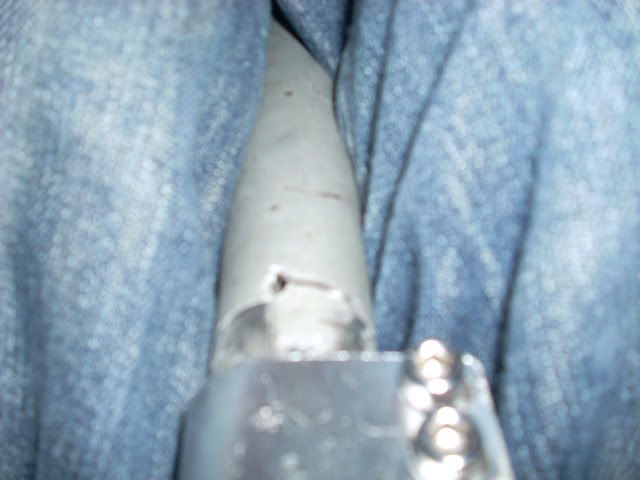FestonGross
Member
i will be giving a review on inwards in a while
it says. right in my first post.Taylor Feist said:slayers are 1 peices
fucking triple posting.Cooper Klaar said:bent and snapped my RAD v3's
0.12" is too thick. The cross bar might not be able to bend, but it puts too much stress on the welds and will cause them to crack over time. For anything over ~0.1" wall you need (for utmost strength) to preheat and post-weld heat treat the bars, which would be a huge waste considering nobody has bent 0.065" cross bar w/ 0.058" steering column. It's overly heavy, and more bound to break because you use the thicker crossbar tubing. And trust me, I'd much rather have my cross bar bend than the welds break and my face/neck be impaled by the sharp chromoly.Gino Troian said:5/5
C4's are pretty much resistant to bending. We use .12" thick crossbar tubing. 100% American cromo.
Cooper Klaar said:bump

yes thats broken
Conor Davidson said:0.12" is too thick. The cross bar might not be able to bend, but it puts too much stress on the welds and will cause them to crack over time. For anything over ~0.1" wall you need (for utmost strength) to preheat and post-weld heat treat the bars, which would be a huge waste considering nobody has bent 0.065" cross bar w/ 0.058" steering column. It's overly heavy, and more bound to break because you use the thicker crossbar tubing. And trust me, I'd much rather have my cross bar bend than the welds break and my face/neck be impaled by the sharp chromoly.Gino Troian said:5/5
C4's are pretty much resistant to bending. We use .12" thick crossbar tubing. 100% American cromo.
You can read some more on here: http://www.lincolnelectric.com/knowledge/articles/content/chrome-moly.asp
"Q. Do I need to pre-heat?
A. Thin wall tubing (< 0.120" wall) applications do not typically require the normal 300Ã?â??Ã?ºF to 400Ã?â??Ã?ºF pre-heat to obtain acceptable results. However, tubing should be at room temperature (70Ã?â??Ã?ºF) or above before welding."
"Q. Do I need to heat treat (stress relieve) 4130 after welding?
A. Thin wall tubing normally does not require stress relief. For parts thicker than .120", stress-relieving is recommended and 1,100Ã?â??Ã?ºF is the optimum temperature for tubing applications. An Oxy/Acetylene torch with neutral flame can be used. It should be oscillated to avoid hot spots."
Well your welder is right on a couple accounts. Sure it is easier to weld, because there is more material there. That's the same reason why aluminum welding is really difficult, because aluminum is much less dense which means there's a lot less material there. With thinner tubing and less dense materials, you do have to be more careful HOWEVER, that doesn't mean the welds are weaker.Gino Troian said:Hey,
I don't know what that shit means but I do agree that the crossbar is very thick. I doubt the welds will break because Rayan Simian has ridden his bars for over 6 months. He has whipped some huge ass gaps and stairsets, most of which people can't even jump. Just recently he just cracked his bars, right on top of the stress cuts (or whatever you call it).
The prototype bars were welded by a beginner welder, but the new bars (V2's) were welded by a professional. The welder had an awesome idea of making a double bead weld, so that when you grind off the first weld to make the bars smooth, there would still be a very thick weld there.
Also, our machinist told us that .12" is great for welding because it is easier to weld, unlike thinner tubing. If we used thinner crossbar metal, the welds would be weaker, and the metal could of been ruined if not welded correctly.
Well your welder is right on a couple accounts. Sure it is easier to weld, because there is more material there. That's the same reason why aluminum welding is really difficult, because aluminum is much less dense which means there's a lot less material there. With thinner tubing and less dense materials, you do have to be more careful HOWEVER, that doesn't mean the welds are weaker.
Think of the saying "When there's blood on the streets, somebody's gotta go to jail." I know it sounds weird but it actually makes sense. Bars USUALLY dysfunction in one of two places: Either the crossbar bends or the welds crack. SO, you'd think you'd be solving the crossbar bending problem by using a thicker wall'd tubing, HOWEVER, because the crossbar won't bend, all the stress goes to the welds. Something has got to give, whether it's the crossbar or the welds...something's gotta go to jail. haha.
Now, no bars are indestructible. Mine will eventually bend, yours will eventually crack. However, bent bars are ridable, cracked bars aren't.
Steven T said:Ive had my RADv1s for over 2 years. No bends at all. And i got brand new RADv2s. And im about to get my Inwards. I love my RADs. And ill post back after i ride my Inwards.
